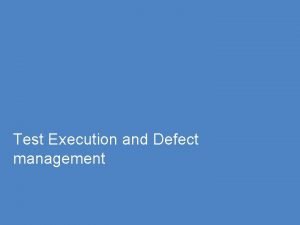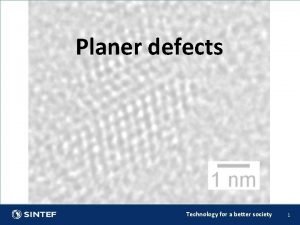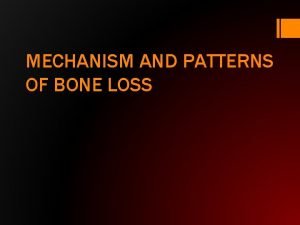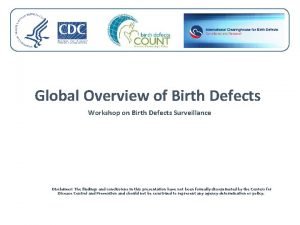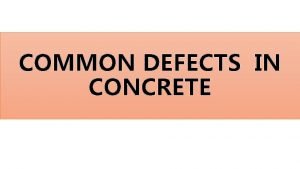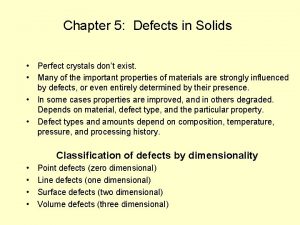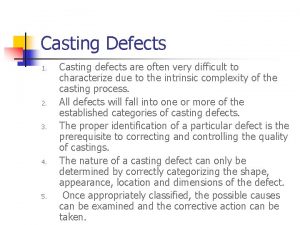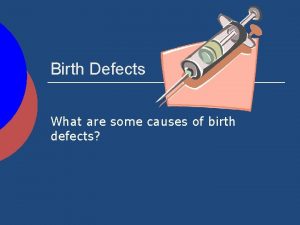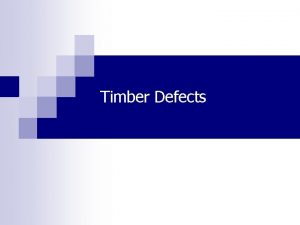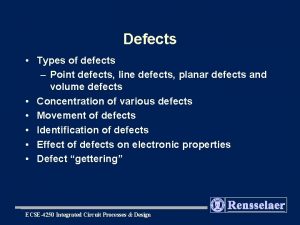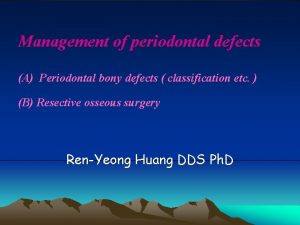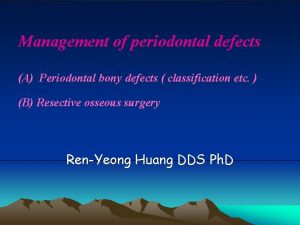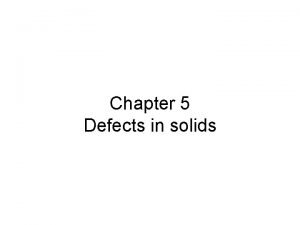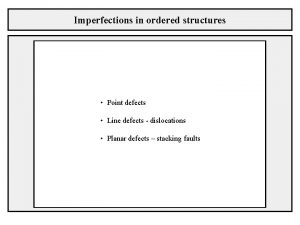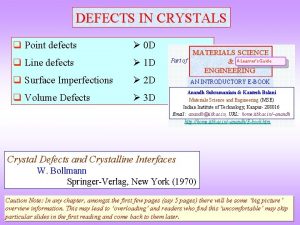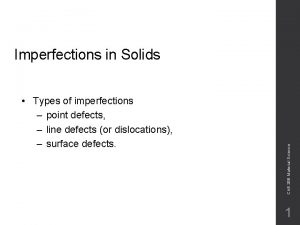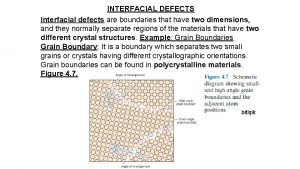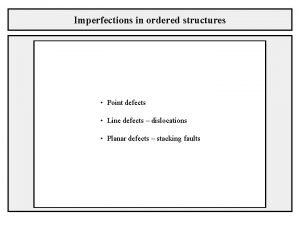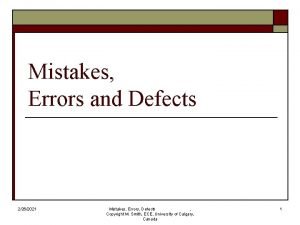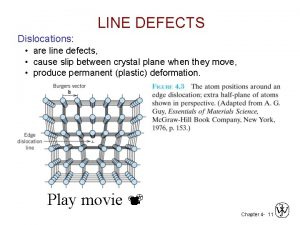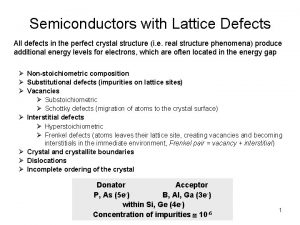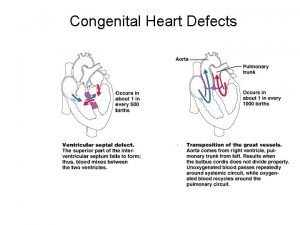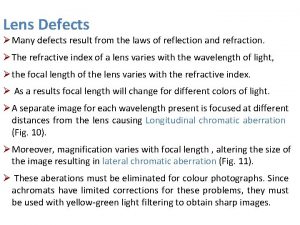CHAPTER 5 Defects management Visit to more Learning




































- Slides: 36

CHAPTER 5: Defects management Visit to more Learning Resources











Different Causes Of Software Defects • One of the extreme causes is the specification • Specifications are the largest producer of defects. • Either specifications are not written, specifications are not thorough enough, constantly changing or not communicated well to the development team. • Another bigger reason is that software is always created by human beings they know numerous things but are not expert and might make mistakes. • Further, there are deadlines to deliver the project on time. • So increasing pressure and workload conduct in no time to • check, compromise on quality and incomplete systems. • So this leads to occurrence of defects in software's.

Defect Classification: • Requirements and specification defect: • Design Defects: • Coding Defects: • Testing Defect: – 1. Test-design defect: – 2. Test-environment defect: – 3. Test-tool defects:

Requirements and specification defect: • Requirement related defects arise in a product when one fails to understand what is required by the customer. • These defects may be due to customer gap, where the customer is unable to define his requirements, or producer gap, where developing team is not able to make a product as per requirements. • Defects injected in early phases can persist and be very difficult to remove in later phases. • Since any requirements documents are written using natural language representation, there are very often occurrences of ambiguous, contradictory, unclear, redundant and imprecise requirements.

Design Defects: • Design defects occur when system components, interactions between the outside software/hardware, or users are incorrectly designed. • This covers in the design of algorithms, control, logic/ data elements, module interface descriptions and external software/hardware/user interface descriptions. • Design defects generally refer to the way of design creation or its usage while creating a product. • The customer may or may not be in a position to understand these defects, if structures are not correct. They may be due to problems with design creation and implementation during software development life cycle.

Coding Defects: • Coding defects may arise when designs are implemented wrongly. • If there is absence of development/coding standards or if they are wrong, it may lead to coding defects. • Coding defects are derived from errors in implementing the code. • Coding defect classes are closely related to design defect classes especially if pseudo code has been used for detailed design. • Some coding defects come from a failure to understand programming language constructs, and miscommunication with the designers. • At times it may be difficult to classify a defect as a design or as a coding detect.

Testing Defect: • Testing defect are defects introduced in an application due to wrong testing • In this defects includes: 1. Test-design defect: test-design defect refers to defects in test artifacts , there can be defects in test plans , test scenarios , test cases and test data definition which can lead to defect in software. • 2. Test-environment defect: this defect may arise when test environment is not set properly. Test environment may be comprised of hardware, software, simulator and people doing testing. 3. Test-tool defects: any defects introduced by a test tool may be very difficult to find and resolve, as one may have to find the defect using manual test as against automated tools. •

Defect/Bug Life Cycle

• • • • New: When a new defect is logged Assigned: Assigns the bug to developer team Open: The developer starts analyzing and works on the defect fix Fixed: When developer makes necessary code change and verifies the change, he or she can make bug status as "Fixed. “ Pending retest: Code for retesting the code. The status assigned is "pending request. " Retest: To check whether the defect is fixed by the developer or not and change the status to "Re-test. " Verified: . If there is no bug detected in the software, then the bug is fixed and the status assigned is "verified. " Reopen: Once again the bug goes through the life cycle Closed: If the bug is no longer exits then tester assign the status "Closed. “ Duplicate: If the defect is repeated twice Rejected: If the developer feels the defect is not a genuine defect Deferred: If the present bug is not of a prime priority Not a bug: If it does not affect the functionality of the application

Defect management process • Defect is basically the difference between the expected result and the actual result. • A defect is a specific concern about the quality of an Application under Test (AUT).

Defect management process

1. Defect Prevention : It consist of implementation of techniques, methodology and standard processes. It will used to reduce the risk of defects. 1. Deliverable Baseline: Establishment of milestones where deliverables will be considered complete and ready for further development work. When a deliverable is baseline, any further changes are controlled. Errors in a deliverable are not considered defects until after the deliverable is baseline.

4. Defect Resolution: This is done by the development team to prioritize, schedule and fix a defect, and document the resolution. This also includes notification back to the tester to ensure that the resolution is verified. 5. Process Improvement : It includes identification and analysis of the process in which a defect originated to identify ways to improve the process to prevent future occurrences of similar defects. Also the validation process that should have identified the defect earlier is analyzed to determine ways to strengthen that process. 6. Management Reporting : It includes analysis and reporting of defect information to assist management with risk management, process improvement and project management.

Which parameters are considered while writing good defect report? • A defect report documents an anomaly discovered during testing by a tester. • It includes all the information needed to reproduce the problem, including the author, release/build number, open/close dates, problem area, problem description, test environment, defect type, how it was detected, who detected it, priority, severity, status, etc. • Defect report is to state the problem as clearly as possible so that developers can easily fix it. • In most companies, a defect reporting tool is used and the elements of a report can vary.


Defect Report Template

What are the points considered while estimating impact of a defect? • There is a strong relationship between the number of defects and the number of test cases and number of function points. • The number of acceptance test cases can be estimated by multiplying the number of function points by 1. 2. • Acceptance test cases should be independent of technology and implementation techniques. • If a software project was 100 function points the estimated number of test cases would be 120 to estimate the number of potential defects.

Techniques to find defects are: a) Quick Attacks: b) Equivalence and Boundary Conditions: C) Common Failure Modes: d) State-Transition Diagrams: e) Use Cases and Soap Opera Tests: f) Code-Based Coverage Models: g) Regression and High-Volume Test Techniques:

Quick Attacks: • he quick-attacks technique allows you to perform a cursory analysis T of a system in a very compressed timeframe. • Even without a specification, you know a little bit about the software then you might attack the system, looking to send it into a state of panic by filling in the wrong thing. • If a field is required, leave it blank. If the user interface implies a workflow, try to take a different route. If the input field is clearly supposed to be a number, try typing a word, or try typing a number too large for the system to handle. If you must use numbers, figure out whether the system expects a whole number (an integer), and use a decimal-point number instead. • Strength: – Finally, quick attacks are quick. – They can help you to make a rapid assessment.

b) Equivalence and Boundary Conditions: • Once you know a little bit about what the software should do, you'll discover rules about behavior and criteria. • For example, think about an application that rates drivers for car insurance. • Figure 1: Example of automobile insurance cost per month, by age

• Figure 1: • Example of automobile insurance cost per month, by age. • Just by looking at the table in Figure 1, you can probably spot a bug or two: – What do we charge someone who's exactly 45 years old? I'll call this the "age 45 problem. " – We don't know how much to charge anyone who's 91 or older. The English paragraph we analyzed cut off at age 90. • Strength: – Boundaries and equivalence classes give us a technique to reduce an infinite test set into something manageable. – They also provide a mechanism for us to show that the requirements are "covered".

C) Common Failure Modes: The heart of this method is to figure out what failures are common for the platform, the project, or the team; then try that test again on this build. If your team is new, or you haven't previously tracked bugs, you can still write down defects that "feel" recurring as they occur and start checking for them.

d) State-Transition Diagrams: Mapping out the application provides a list of immediate, powerful test ideas. Model can be improved by collaborating with the whole team to find "hidden" states transitions that might be known only by the original programmer or specification author. Once you have the map, you can have other people draw their own diagrams, and then compare theirs to yours. The differences in those maps can indicate gaps in the equirements, defects in the software, or at least different expectations among team members.

e) Use Cases and Soap Opera Tests: Use cases and scenarios focus on software to enable a human being to do something. Use cases and scenarios tend to produce clear scenario with business customers, and if done as part of the requirement process, they sort of magically generate test cases from the requirements. They make sense and can provide a straightforward set of confirmatory tests. Soap opera tests offer more power, and they can combine many test types into one execution.

What is Defect Severity? defect severity can be defined as the degree of impact a defect has on the development or operation of a component application being tested. Defect severity can be categorized into four class 1. Critical: This defect indicates complete shut-down of the process, nothing can proceed further 2. Major: It is a highly severe defect and collapse the system. However, certain parts of the system remain functional 3. Medium: It cause some undesirable behavior, but the system is still functional 4. Low: It won't cause any major break-down of the system

What is Defect Priority? Defect Priority states the order in which a defect should be fixed. Higher the priority the sooner the defect should be resolved. Defect priority can be categorized into three class 1. Low: The defect is an irritant but repair can be done once the more serious defect have been fixed 2. Medium: During the normal course of the development activities defect should be resolved. It can wait until a new version is created 3. High: The defect must be resolved as soon as possible as it affects the system severely and cannot be used until it is fixed. For more Details Contact Us
 More more more i want more more more more we praise you
More more more i want more more more more we praise you More more more i want more more more more we praise you
More more more i want more more more more we praise you Learning from defects tool
Learning from defects tool Cuadro comparativo e-learning y b-learning
Cuadro comparativo e-learning y b-learning Total branch automation
Total branch automation The more you take the more you leave behind
The more you take the more you leave behind The more you study the more you learn
The more you study the more you learn Aspire not to have more but to be more
Aspire not to have more but to be more Newton's law
Newton's law Knowing more remembering more
Knowing more remembering more The more i give to thee the more i have
The more i give to thee the more i have More choices more chances
More choices more chances Human history becomes more and more a race
Human history becomes more and more a race Site:slidetodoc.com
Site:slidetodoc.com Execution defects
Execution defects Twinning tablet defects
Twinning tablet defects Secondary education commission (1952-53)
Secondary education commission (1952-53) Drop core
Drop core Chain sling defects
Chain sling defects Armany classification
Armany classification Defects per million opportunities formula
Defects per million opportunities formula Dpmo in six sigma
Dpmo in six sigma Planer defects
Planer defects Physical defects in personality development
Physical defects in personality development Crater defect perio
Crater defect perio Spina bifida
Spina bifida Which defect in timber is caused by the growth of branches
Which defect in timber is caused by the growth of branches Silver streaks in injection moulding
Silver streaks in injection moulding Types of concrete defects
Types of concrete defects Defects in butter
Defects in butter Defects in solids
Defects in solids Localised shrinkage porosity
Localised shrinkage porosity Casting defect
Casting defect Birth defects causes
Birth defects causes Congenital cardiologist near me
Congenital cardiologist near me Rind galls
Rind galls Radial shakes in timber
Radial shakes in timber














